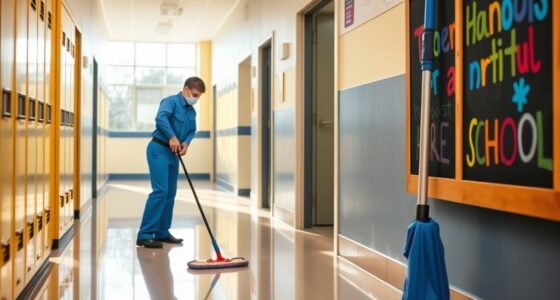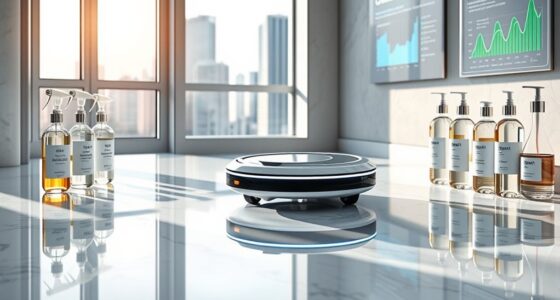To guarantee a healthy shared workspace, disinfect high-touch surfaces several times a day and maintain a daily cleaning routine in busy areas. Use EPA-registered disinfectants and follow manufacturer’s guidelines for effectiveness. Keep cleaning supplies stocked and hold regular training sessions to boost employee awareness. Establish a disinfection schedule with clear responsibilities for everyone. Improve air quality with regular maintenance of purifiers. Discover more ways to elevate your workspace hygiene and create a safer environment.
Key Takeaways
- Disinfect high-touch surfaces multiple times a day to minimize germ spread and enhance workplace safety.
- Use EPA-registered disinfectants and follow manufacturer instructions for effective pathogen elimination.
- Implement a cleaning schedule for high-traffic areas, intensifying efforts after employee illness.
- Provide visual hygiene reminders and regular training to increase employee awareness and adherence to cleaning protocols.
- Schedule professional cleaning services to ensure thorough disinfection and maintain indoor air quality.
Importance of Disinfection in Shared Workspaces
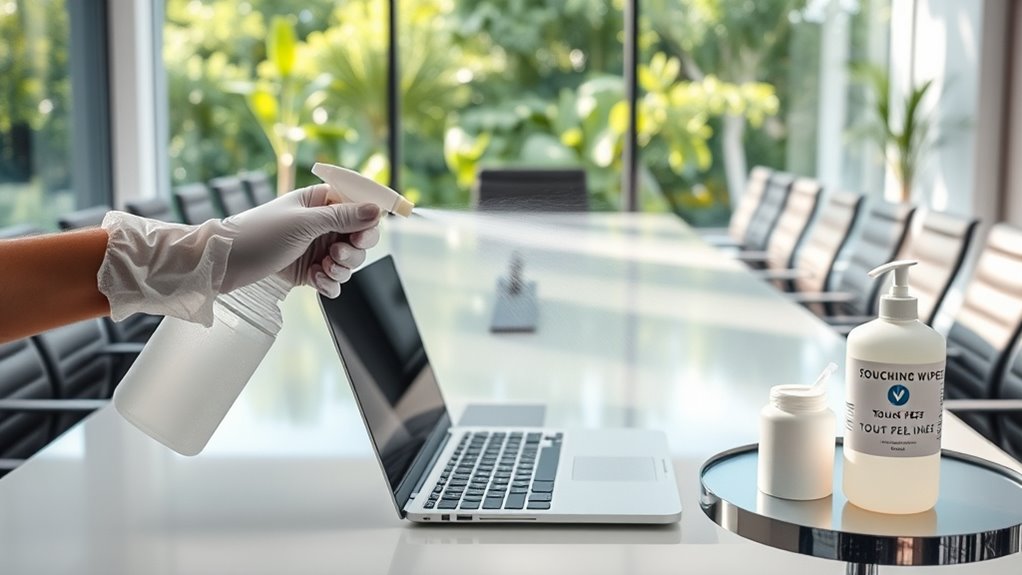
Disinfection in shared workspaces is essential because high-contact surfaces can easily become breeding grounds for germs. By implementing regular disinfection practices, you not only protect your health and safety but also create a more productive environment.
Surfaces like doorknobs and keyboards can harbor thousands of germs, increasing the risk of illness among employees. When you prioritize disinfection, you can reduce absenteeism by up to 40%, boosting morale and overall productivity.
Clean, disinfected spaces contribute to a 20% increase in employee satisfaction, fostering a culture of well-being. Following proper cleaning practices, especially during flu season, demonstrates your commitment to your team’s health, enhancing your company’s professional image and building client trust.
Prioritize disinfection for a thriving workplace.
Recommended Disinfection Frequency
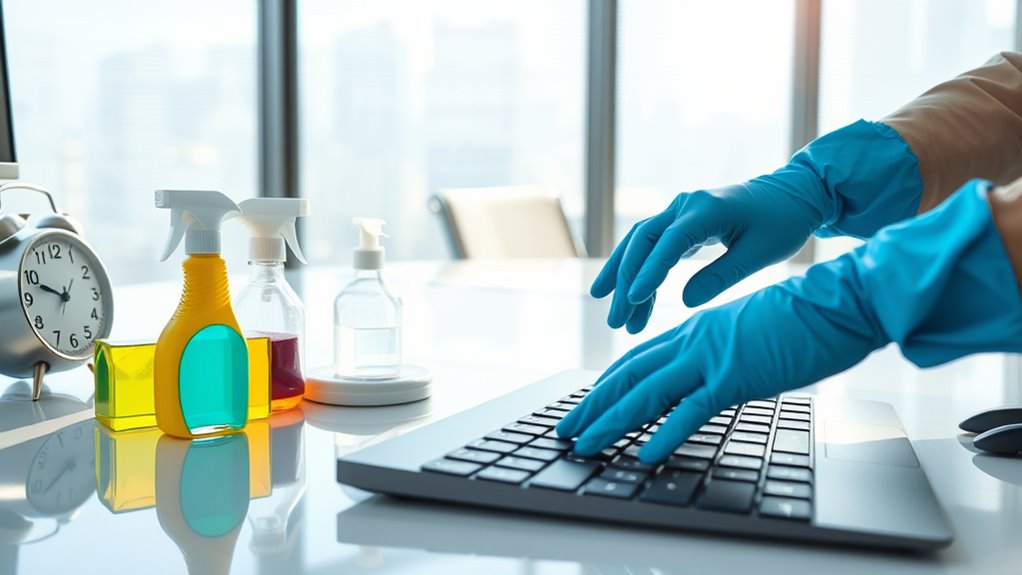
To maintain a healthy shared workspace, establishing a recommended disinfection frequency is vital. You should disinfect high-touch surfaces, like doorknobs and keyboards, multiple times a day to minimize germ spread.
Establishing a disinfection routine for high-touch surfaces is essential to minimize germ spread in shared workspaces.
In shared spaces, aim for a cleaning routine that includes daily attention to high-traffic areas. For larger offices, consider a schedule that involves cleaning and disinfecting up to five days a week.
If an employee falls ill, intensify your efforts by thoroughly disinfecting common areas to protect others. Consistent cleaning not only promotes a healthier work environment but also encourages everyone to follow the established protocols.
Regularly monitoring and gathering feedback on your cleaning routine can help facilitate adherence and identify areas needing more frequent disinfection.
Effective Cleaning Techniques for High-Touch Surfaces
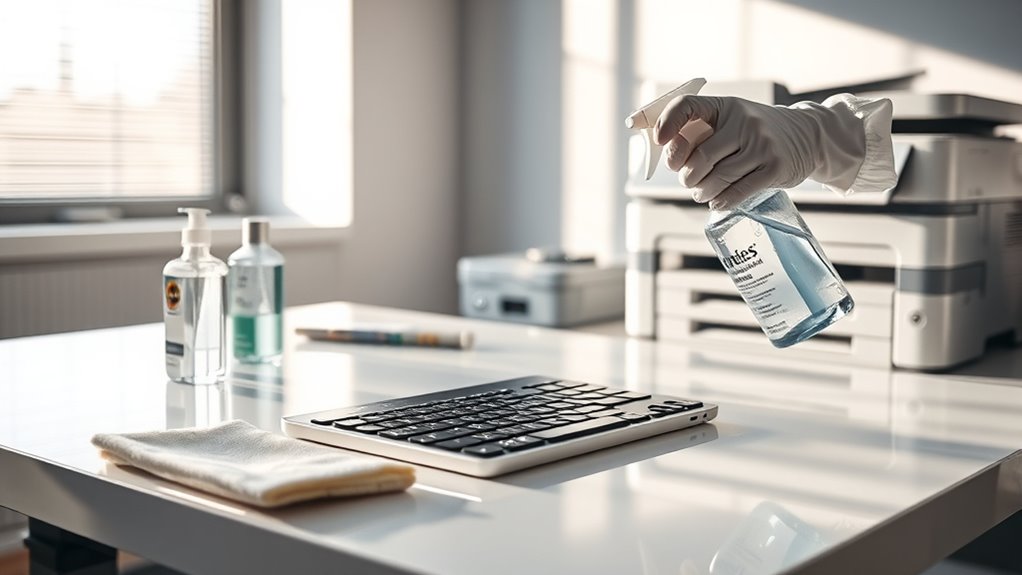
When you’re cleaning high-touch surfaces, it’s essential to apply disinfectants properly to target those areas effectively.
Focus on spots like doorknobs, keyboards, and light switches, as they collect the most germs.
Proper Disinfectant Application
How can you guarantee that high-touch surfaces in shared workspaces are effectively disinfected?
Start with thorough cleaning to remove dirt and residue, as these can hinder disinfectants’ effectiveness. Use EPA-registered disinfectants proven against specific pathogens, and follow the manufacturer’s instructions, especially regarding contact time.
When applying disinfecting products, wipe surfaces like doorknobs and keyboards in one direction to minimize cross-contamination. Regularly replace your cleaning materials, like wipes and cloths, to avoid transferring germs.
Ascertain proper ventilation when using disinfectants and wear appropriate personal protective equipment (PPE) to protect against chemical exposure.
Targeting High-Contact Areas
Effective cleaning techniques for high-touch surfaces are essential for maintaining a safe shared workspace. High-contact areas like doorknobs and light switches can harbor thousands of germs, so you must prioritize disinfecting them.
Here are some key practices to follow:
- Disinfect high-touch surfaces at least once daily, increasing frequency after illness.
- Use EPA-registered disinfectants effective against common viruses, ensuring a contact time of under three minutes.
- Employ single-direction wiping techniques to prevent cross-contamination on surfaces like keyboards and phones.
- Regularly train employees on effective cleaning methods and encourage the use of accessible sanitizing materials.
Essential Disinfecting Supplies and Equipment

When it comes to maintaining a clean workspace, choosing the right disinfectant solutions is vital.
You’ll want to stock up on effective cleaning tools, like microfiber cloths and disposable wipes, to guarantee thorough sanitation.
Let’s explore the essential supplies you need to keep your shared environment safe and healthy.
Disinfectant Solutions Selection
What disinfectant solutions should you choose for shared workspaces? Selecting the right products is essential for effective sanitation. Here are key options to take into account:
- EPA-registered disinfectants: Verify they target common pathogens and have a contact time under three minutes.
- Disinfectant wipes: Perfect for quick application on high-touch surfaces like keyboards and doorknobs.
- Eco-conscious disinfectants: Look for products with EPA Design for the Environment (DfE) certifications to minimize environmental impact without sacrificing efficacy.
- Electrostatic sprayers: These advanced tools provide thorough coverage, enhancing your overall disinfection efforts.
Cleaning Tools Essentials
Choosing the right disinfectant solutions is just the beginning; the tools you use for cleaning play an essential role in maintaining safe shared workspaces. Start with EPA-registered disinfectants, which effectively combat common pathogens in under three minutes.
For your cleaning tools essentials, invest in microfiber cloths—they trap dust and bacteria without scratching surfaces. Disposable disinfecting wipes are perfect for quickly sanitizing high-touch areas, minimizing cross-contamination risks.
Don’t forget personal protective equipment (PPE) like gloves and masks for your cleaning staff’s safety while using these chemical disinfectants.
Finally, consider automated cleaning devices, such as electrostatic sprayers, to enhance your disinfecting efforts, ensuring thorough coverage and reducing chemical waste. These tools collectively boost your cleaning effectiveness in shared spaces.
Creating a Disinfection Schedule and Responsibilities
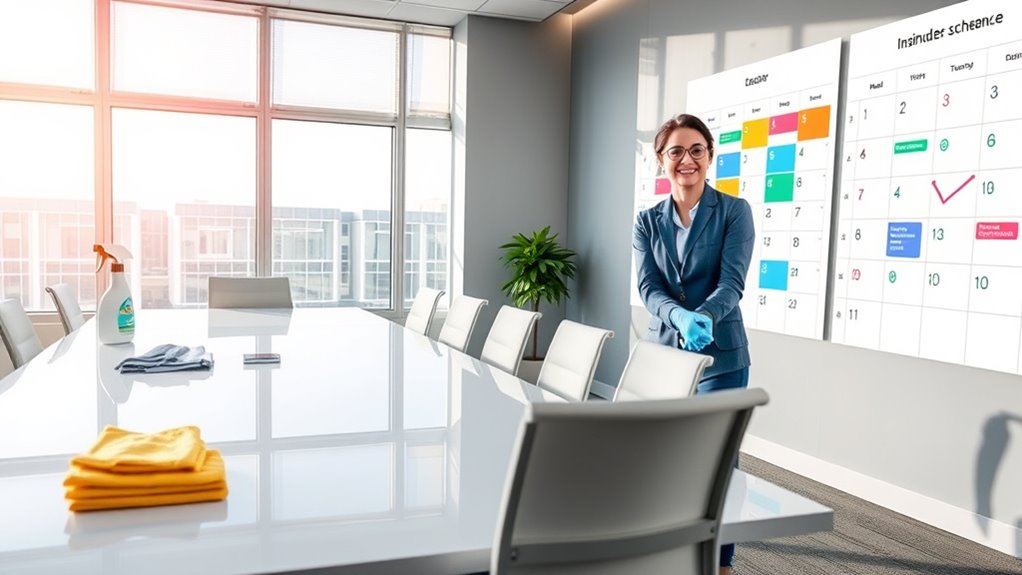
To maintain a clean and healthy shared workspace, it’s essential to create a disinfection schedule that prioritizes high-touch surfaces.
Here’s how to effectively manage cleaning responsibilities:
- Daily Disinfection: Clean high-touch surfaces like doorknobs, keyboards, and light switches every day.
- Assign Roles: Make sure everyone knows their cleaning responsibilities to foster accountability.
- Use a Checklist: Implement a checklist to streamline disinfection tasks and cover all important areas.
- Regular Reviews: Set a review cycle for the disinfection schedule, adapting it based on occupancy levels and health advisories.
Enhancing Air Quality and Ventilation
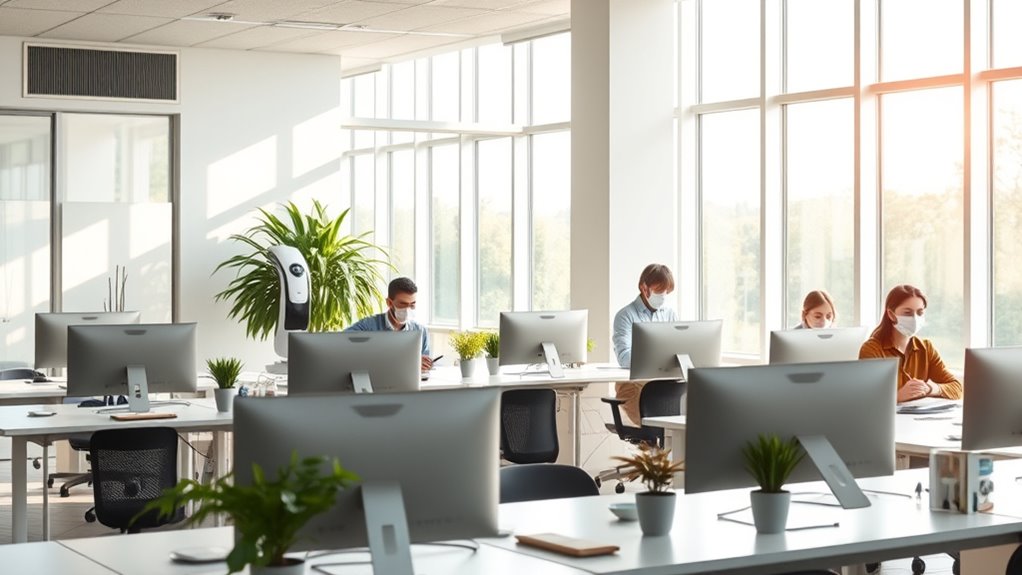
While maintaining cleanliness through disinfection is vital, enhancing air quality and ventilation in shared workspaces is equally important for overall health. Proper ventilation reduces airborne contaminants, greatly lowering the risk of transmitting viruses and bacteria. Utilizing HEPA filters in HVAC systems traps 99.97% of particles, improving air quality. Regularly opening windows can further boost airflow and dilute indoor pollutants. Additionally, air purifiers with UV-C light technology neutralize airborne pathogens, guaranteeing a healthier environment. Implementing a routine maintenance schedule for your ventilation systems is essential for peak performance.
| Action | Benefit |
|---|---|
| Use HEPA filters | Traps 99.97% of particles |
| Open windows | Improves airflow and dilutes pollutants |
| Install air purifiers | Reduces airborne pathogens |
| Maintain HVAC systems | Guarantees peak air quality |
| Regular office cleaning | Minimizes dust and allergens |
Encouraging a Culture of Cleanliness Among Employees

Here are four effective strategies to encourage this culture:
- Promote Personal Responsibility: Encourage everyone to maintain their clean workspace and take ownership of hygiene.
- Visual Reminders: Use signage to highlight hygiene protocols and increase employee awareness about cleanliness.
- Regular Training: Implement training sessions focused on effective cleaning techniques, especially for high-touch areas.
- Utilize Cleaning Services: Guarantee professional cleaning services are regularly scheduled to maintain a clean office.
A clean work environment boosts morale and productivity, making it essential for a thriving workplace culture. Additionally, implementing effective air purifier maintenance can further enhance indoor air quality and contribute to overall employee wellness.
Frequently Asked Questions
How Do I Keep My Workspace Clean?
To keep your workspace clean, start by regularly wiping down high-touch surfaces like your keyboard, phone, and desk.
Make it a habit to declutter daily and organize your materials.
Use EPA-approved disinfectants and follow the instructions for effective cleaning.
Encourage good hygiene by washing your hands frequently and using hand sanitizer.
Finally, consider scheduling professional cleaning services weekly to maintain a healthy environment and reduce the risk of illness.
How to Disinfect a Work Desk?
Did you know that desks can harbor 400 times more bacteria than a toilet seat?
To disinfect your work desk, start by decluttering to access all surfaces. Use an EPA-registered disinfectant spray or wipes, applying it to high-touch areas like your keyboard and phone.
Make sure to wipe in one direction for effective cleaning. Aim to sanitize your desk at least once daily, particularly during flu season, to keep germs at bay.
How Can You Disinfect the Working Space?
To disinfect your working space effectively, start by cleaning surfaces to remove any dirt and residues.
Target high-touch areas like doorknobs, keyboards, and light switches, as they harbor germs.
Use EPA-registered disinfectants and let them sit for the recommended time to guarantee they work properly.
Establish a regular cleaning schedule, and consider assigning cleaning tasks to team members to maintain accountability and consistency in hygiene practices throughout your workspace.
How Do You Disinfection a Working Area?
To disinfect a working area, start by cleaning surfaces to remove dirt and grime, which can hinder disinfectants’ effectiveness.
Use EPA-registered disinfectants and follow the manufacturer’s instructions. Pay special attention to high-touch areas like doorknobs and keyboards.
Create a cleaning schedule for daily sanitization and weekly thorough disinfection of these surfaces.
Train your team on proper techniques, including single-direction wiping, to prevent spreading germs and guarantee effective cleaning.
Conclusion
To sum up, maintaining a clean workspace isn’t just about hygiene; it’s about creating a thriving environment for everyone. By sticking to a regular disinfection routine and using the right supplies, you’re not only protecting health but also boosting morale. When everyone pitches in and embraces a culture of cleanliness, it’s amazing how quickly you’ll notice a positive shift. So, let’s make cleanliness a shared goal—after all, a clean workspace just might spark that next big idea!




